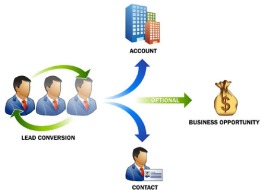6 Steps for lead conversion
Sales leads are the crucial success point to any business-to-business (B2B) industry.

If you know when someone is looking to buy a product or service that you offer, you can contact them directly, pitch your service, and spell out their return on investment to secure the sale.
However, too much focus is placed on these quick win sales. What about the potential customer who doesn’t know how you can help them yet? What about the potential customer who wants a bit more information on prices? Surely they are just as valuable in the long term.
Only 27% of business to business (B2B) leads are sales-ready when first generated. This makes lead conversion essential for capitalizing on the other 73%, but up to 65% of B2B marketers have not established lead nurturing campaigns.
This begs the question: Can I make my lead generation campaign nurture opportunities for the future? The answer is yes, and here is how…
Understand the Online Marketing Funnel
The traditional marketing funnel encompasses all marketing activity from PR to print advertising. However, from an online perspective, you can monitor and analyze anyone who is looking at your online activities and tailor your approach to reach them.

Essentially the four main elements of the online marketing funnel are:
Audit
Take a look at your current online traffic levels and conversion ratios. Do they match up? Some webmasters get obsessed with visitor levels, but having a lot of visitors without conversions to me only equals one thing: A leaky marketing funnel. Although people are interested in your product or service, you are losing them at the final hurdle.
This is where lead nurturing comes into play. By gaining information such as an email address, name, or phone number, you can continue to monitor and connect with them, ensuring they don’t fall off your radar and buy from a competitor.
Make sure you are monitoring online leads and conversions, but are finalizing sales by phone. The easiest way to do this is use a visitor level call tracking system. In the majority of B2B industries, a phone call is definitely a prerequisite before a sale is made.
Target, Target, Target!
After you have narrowed down what should be included in your online leads funnel, you need to put a plan in place to make sure you’re reaching the right people. Deciding how you judge which point of the sales process different customers are at is essentially deciding what it means to be sales ready. The more you can find out about a website visitor, the closer you can match their requirements with what you can offer them.
A study suggests that our brains help us to focus on one thing by allowing us to ignore everything else. This really puts emphasis on creating something that visitors really want to see; otherwise you simply become part of the white noise. Target quality leads over quantity, and use your strategy to nurture relationships with people who want to be targeted.
Leverage Existing Databases
Existing databases are an invaluable resource, especially for your lead nurturing efforts. When marketing budgets are tight, spending them on sourcing new leads will eat into your profits. Why go to that trouble when you have an entire list of past customers who may be looking to buy again?
One of the most important messages to take away from this is the more effort you put into creating a database and keeping it up to date, the more leverage you have to align them to you brand again.
Content Marketing on Steroids
Having a great product will be little use if no one knows about it, and social media is often the first stage of the online discovery process. To have a good social media campaign, you must first have some great content to share. To make the content work for you, you have to have a great website that offers a unique service. Content is what holds social media and product together.
Create some exciting content that will educate your potential buyers on exactly what you can do for them, testimonials on what you have done for others and establishing yourself as a thought leading brand in your industry is what you should be aiming for. This takes strategy and time to build up, but linking social to content is an absolute power house for lead attraction and conversion. High quality content that is contextually relevant sent to potential clients leads to a 208% higher conversion rate than batch and blast.
Hard selling is not needed and is often inappropriate in the first establishing steps to generating and nurturing a lead, but if you’re able to show how you can help a potential customer, using statistics and offering something of value to the reader or establishing your business as a thought leader, you’ll be able to get people thinking: “if they know this about my sector, and are giving it away for free… what else do they know and how can they help me?”
Decision Maker’s Needs
Although you are looking at your online marketing strategies, working closely with an offline sales team is essential. By understanding the buyer, you can understand their needs and wants and evaluate how best to nurture this lead. Targeting people around the decision maker in a business is likely to be useful and if you can schedule in-person meetings to get in front of the people they answer to, you’ll have a better chance at getting ball rolling and making the lead into a sale.
The average number of people involved in a decision is 6.8 — and that number goes as high as 21 individuals on buying committees at larger companies. Your nurturing content will need to speak to each of them individually and address their unique needs.
Lead nurturing is more than simply pressurizing people who are not ready to buy into purchasing. If done right, it can create a loyal customer base that trusts what you offer and believes in what you do. Taking a visitor from the initial website visit through to sale is a skill which will become increasingly valuable as the internet markets become increasingly wide and competitive. Get a head start today and begin formulating a lead nurturing plan for your business.
For more details contact me at contacttim82@gmail.com
SEO Best Practices: Setting Up a Blog
One mistake many businesses still make is creating posts that consist of self-promotion with little “meat” to entice anyone to engage with the content, much less share the content.
Usually post should be relevant to the topic and to the point.

Setting Up Your Blog
Once you know you’re trying to achieve, you need to consider where the blog resides. Should you use a sub-directory, a sub-domain, a completely separate domain, or either WordPress or Blogger? Let’s look at all the options.
Blog on a Subdirectory
More often than not, this is how I recommend clients set up a blog. In my opinion adding fresh content to the root domain is a good thing. I also believe that having an RSS feed of “latest blog posts” to the home page of the website is a good thing.
I believe that promoting content that resides “on” the website is a good thing because you can earn links and provide balance to your link profile. And, I believe that having thought-leadership content that is closely associated with your brand is a good thing.
Pros:
- Add fresh content to the root domain.
- Add deep links (from other websites)/social signals directly to root domain (assuming that you’ve promoted this content well).
Cons:
- Won’t provide an additional “brand” listing (in most cases) in the SERPs, so doesn’t serve well for reputation management.
- No direct ability to get links “from another website/sub-domain”.
Blog on a Subdomain
A good case can be made for why you might want to blog on a subdomain.
For example, perhaps you have issues with reputation management (perhaps someone posted to review complaint sites like Ripoff Report, Pissed Consumer, etc.) so you need to occupy additional real estate in the SERPs. By building your blog on a subdomain, you accomplish this by providing the search engines another “official web presence” (the search engines will treat this as a separate entity) for your company, that should rank when folks search your company name.
The nice thing about having a blog on a sub-domain is that it will also piggyback on the authority of your root website (hopefully you already have some authority on your root domain) and posts there can rank, without the need to build up the authority for a new website.
Pros:
- Get an additional brand presence in the SERPs that you control.
- Get links “from another website”; Ability to deep-link to specific pages within the root.
- Piggyback on the already “built” authority of the root domain.
- Can be hosted anywhere. Very important consideration for those on a content management system that does not provide a blogging platform.

Blog on WordPress.com or Blogger
Some pretty large companies have gone this route because – to them – it’s the easiest to execute. Mind you, a link from WordPress.com isn’t a bad thing, but how does this help with any of the aforementioned reasons why you might want to blog in the first place?
Are you tying in the “thought leadership” to the brand? Are you adding fresh content to the domain? Are you aiding your abilities to provide an additional “official brand presence” to the SERPs? (Perhaps, but you’re better off with subdomain).
Pros:
- You could create some very aggressive link building tactics or “test” things without burning the domain.
- You would gain a link that is coming from an authority domain (remember, a quality link profile is about gaining links from many different/authoritative/relevant websites/domains; not many links on one domain)
- Easy. Just about anyone can get engaged and start blogging today.
Cons:
- Limitations as to how you can design/template to fit your brand.
- Any content promoted (linked to) won’t provide direct value to your main company website/domain.
- Inability to utilize plugins.
- Cheesy. It is what it is. Not gonna be a great representation for your company.
Blog on a Separate Domain
Some people like to create a “non-official” blog presence, to have control over a website that isn’t directly tied to the brand. They want to have an “unbiased” voice and probably use this to occasionally link to their main website.
I typically discourage these types of initiatives, for many reasons – not the least of which is the amount of effort that would need to go into making this new web presence gain any amount of trust/traction or authority.
Pros:
- Can create an “unbiased” resource (that just happens to link to your corporate website, on occasion).
- If the content is good, and it becomes respected in your industry, the blog can gain authority that can then be passed through to your corporate website through “unbiased” linking.
Cons:
- There’s a better than average chance that gaining good authority/ability for posts to rank is going to take considerable time.
- Does little to really show thought-leadership for your company.
- If you really do drop links to the corporate website, there’s a good chance that it’ll be seen for what it is: a paid advertisement, not an official unbiased reference. The backlash from this could be (should be) huge.
Cons:
- Not as much freshness on the domain.
- Content that “hits” (gets good promotion/links) doesn’t add as much link value to the root.
SIMPLE TIPS FOR HAVING GREAT MEETINGS FROM SOME OF THE WORLD’S MOST PRODUCTIVE PEOPLE
A recent U.K. study showed that the average office worker spends around 16 hours in meetings each week. That’s over 800 hours a year. For a grand total over an entire career of–are you sitting down?–37,440 hours of meetings. That’s more than 4 years of your precious time. Shocking.. Isn’t it?

Here are the strategies to get your office meeting off life support.
1. Pretend you’ve already failed.
Guy Kawasaki, a business guru and best-selling author, advises business leaders to gather their team before making critical decisions such as launching a product or service. He suggests seizing these moments to say, “Let us pretend that our product, our company failed. Now, what are all the possible reasons?” The reasons may include lack of distribution, an unsophisticated sales force, buggy software, or unreliable cloud services. According to Kawasaki, the point is to get people imagining everything that could go wrong, so they can take steps to remedy problems before they happen. In other words, he says, “Conduct a pre-mortem so that you never have to conduct a post-mortem.”
2. Keep it Novel.
Richard Branson, Virgin founder, writes about adding novelty to freshen up meetings. He invites thought-provoking speakers in diverse fields from astronomy to nanotechnology to get groups thinking in “new, exploratory ways.” And he holds discussions in innovative spaces.
3. Pause.
Clay Shirky, an author who covers the social, economic, and cultural effects of the Internet, has a bit of advice for those who charge off to meetings in a frenzied, preoccupied state. Shirky learned an important lesson when he was a student in London. To get into a receptive frame of mind for his studies he would pause during his walk over the river Thames on his way to the lecture hall.
4. Don’t squander youth.
Sean Higby, COO of Newsala, a real-time media app, believes that there is great value in the opinions of junior colleagues. He regularly invites them to meetings and solicits their feedback. Higby says, “Their ears are often closer to the street so they instinctually know what your customers want. Often they’re working for you because they’re a fan of the industry and are up on the latest, yet-to-be-reported trends, and their opinions are not clouded by what other people think is not possible.”
5. Say it in 5 words.
Christopher Frank, an author and vice president at American Express, has some words of wisdom for those trying to answer the question: “What exactly are we meeting about?” He suggests a Twitter-like hack–start your meeting by asking each person to articulate in five words or less the problem to be solved. If the answers are inconsistent or too long, your attendees are probably not focused on the same problem. “By clearly articulating the issue,” Frank wrote in an article for Forbes, “you will get a good idea of the information you need, the people you should talk to and will ensure everyone is working towards the same goal.”
6. Think like a director.
Patrick Lencioni president of The Table Group, a management consulting firm, and the author of Death by Meeting, believes that the cure for boring and unproductive meetings is to think of them as if you were a movie director. He suggests replacing “agendas and decorum with passion and conflict.” This will engage people and give them something to care about. “The good news,” he says, is that “there are plenty of issues at every meeting that have the potential for productive, relevant conflict.”
7. Get them laughing.
Suzanne Bates, founder of Bates Communications, who coaches executives says, “Humor actually increases your stature as a leader.” She goes on to explain that, “If you can warm up the room and make people smile, you stand out. You gain the respect of your colleagues, you appear confident and in control.” As a colleague of hers added, “Who looks like a leader–the person who is stiff and formal, or the one who can help the whole group loosen up?”
8. Bring something to the table or don’t come at all.
Al Pittampalli, author of Read This Before Our Next Meeting, believes in requiring those who come to your meetings to “turn up in mind and spirit and contribute something.” This could include “asking questions, sharing insight or offering to take on tasks.” Pittampalli suggests making this message stick by letting everyone know that if they aren’t bringing added value they won’t be invited to future meetings.
9. Be like a talk show host.
For two years, Ian Fisher, an assistant managing editor at The New York Times, ran the newsroom’s morning meeting in which editors from different sections battle vigorously for best play of their stories. Fisher had to allow enough time for complicated information to be communicated as well as leave time for discussion to deepen coverage. “But a half an hour is about a normal human’s attention span,” he says. He had to know when to bore in, and when to move on. “I called myself Regis,” he told us. “Say what you want, but he knew when it was time to go to the commercial.”
10. Use meetings to beget meetings.
For those of you just getting started and trying to network your way to success, here’s a tip from Valentina Rice, a champion networker and founder of Many Kitchens, an online artisanal food marketplace. Rice’s father, a prominent English businessman, often told her, “Never leave a meeting without getting the names of two more people to meet.”
Top 5 ways of Lead Generation
1) Direct Mail to your Best Buyers
The fastest way to build your business is to target the best customers with a“laser-focused” approach with direct mail to your “best buyers.” This strategy alone has helped many businesses literally double their revenues in just 12 to 18 months (or less). This disarmingly simple strategy is one of the most effective and least expensive ways to market and grow your business… fast!

2) Buy leads from lead brokers and leads companies
Another great way to generate hot “ready to buy” leads is to purchase them from lead brokers and lead companies. These company’s sole focus is to generate leads and them sell them to companies like you who want a great source of consistent new business.

3) Buy leads from the Internet Search Engines
One of the most effective online strategies for generating leads is by attracting targeted traffic to your Website with the “Pay-Per-Click” Search Engines (PPCSEs). PPCSEs can and should become an indispensable part of your lead generating arsenal.
The 2 best PPCSEs are…
- Google AdWords http://www.google.com/ads/
- Overture http://www.overture.com/

4) Advertise
Studies show that 50% of all purchasing is motivated by advertising. Advertising is also one of the best tactics for generating leads that a company can deploy. Plus, it’s also the great way to build name recognition in the market which can get you publicity, “word of mouth” advertising, and other great benefits.
Here are a few tips for running an advertising campaign that brings you a high return on investment…
- Place ads in the most targeted publications that your target market reads.
- Consider inexpensive ads in e-mail newsletters and Web Sites that your target market reads.
- Use direct response ads – always ask the reader of your ad to respond for more information by phone, mail or via your Web Site.
- Be proactive. Have a follow-up system in place to get maximum results from your advertising dollar.
- Use a compelling headline that introduces the biggest benefits your product or service offers your client.
- Make them an offer that they’d be crazy to refuse so they’ll respond and become a new long-term client.

5) Referrals
Referral marketing is one of the most effective techniques for creating steady streams of prospects and clients. Plus, according to a survey, 70% of Internet users are compelled to visit new web sites through referrals.
Here are a few tips…
- Give your customers an incentive or additional products or services in return for referring others to you.
- Use a “Give a Gift” referral system where you invite your clients to give a free sample of your product or service to others as a gift. Referral gift certificates are great tools for this.
- Use a “Loss Leader” referral system. Here’s how it works… Advertise a free sample to get new clients to try out your product or service. This alone will get you more sales. Plus, you can build a perpetual referral generator by giving each person who tries your freebie 3 or more referral gift certificates to give away to their friends and family. Then, watch your new referral system take off and bring you a steady flow of new customers!
- Along with your mailed or e-mailed invoices to clients, include surveys that ask for feedback about how to improve company’s product or service. Be sure to ask for referrals in the survey as well. This works!
- Identify and create relationships with non-competitive companies and people who already serve your target market. Then partner with them and have them automatically refer you to their database of clients. Give them an incentive if possible and watch your business grow!













